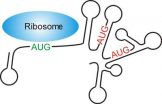The study by Dr Stephen Griffin and colleagues, published in the journal Hepatology, reveals how two prototype small molecule drugs, known as p7 inhibitors, can each attack different parts of the hepatitis C virus. Their findings suggest that p7 inhibitors could be a powerful way of suppressing hepatitis C, when used together with the latest generation of 'direct-acting' drugs.
More than 170 million people - or 3% of the world's population - are infected with the hepatitis C virus. The virus causes severe liver disease and is a leading cause of liver-related deaths, organ transplants and liver cancer.
At the moment, patients are typically treated with PEGylated interferon alpha (IFN) and ribavirin (Rib) - drugs that work by boosting the patient's immune system. However, the effects of these drugs can depend on the individual patient's genetic make-up. To make matters worse, hepatitis C is often resistant to the therapy and fails to suppress the virus for long enough. The treatment is also expensive and can trigger unpleasant side effects. Many patients stop taking the drugs or do not take them when they should.
To address this, researchers are looking at new classes of drugs that work in a different way to either IFN or Rib and target the virus directly. The aim is to find groups of these 'direct-acting' drugs that each attack a different target, making it much, much harder for the virus to fight back.
University of Leeds researchers are focusing on drugs that target the p7 ion channel - a protein made by hepatitis C that allows the virus to continue spreading. In previous studies, Dr Griffin and colleagues worked out how the p7 ion channel could be blocked by certain types of small molecule, stopping the hepatitis C virus in its tracks. Their latest work looks at two particular classes of p7 inhibitor - adamantanes and alkylated imino-sugars – and confirms that these molecules do, indeed, attack their intended target through separate mechanisms.
The researchers used a combination of molecular modelling and lab-based experiments to study the drugs' interaction with hepatitis C. Importantly they observed how the virus responded to the two types of drug and determined that each of these responses was very different. This suggests that the drugs would work well in combination, tackling the virus on a number of fronts.
Lead author, researcher Dr Stephen Griffin, from the University of Leeds' School of Medicine, said: "Hepatitis C has always been an extremely difficult condition to treat effectively because the virus evolves so quickly and develops resistance to drugs that are used to treat it. This new class of small molecule drugs, the p7 inhibitors, attack the virus directly. As we have discovered here, they each do so in quite a different way which allows us to combine their effects.
"By learning how the hepatitis C virus reacts to these molecules, we can design drugs that are likely to be more effective for longer. We can also see how such drugs could be used together with other 'direct-acting' drugs that target alternative viral targets, rather than individually or with IFN/Rib. In other words, a similar approach to treatment as that used for HIV."
INFORMATION:
The study was conducted in collaboration with Professor Mark Harris (University of Leeds, Faculty of Biological Sciences), Professor Colin Fishwick and Dr Richard Foster (University of Leeds, School of Chemistry) and Professor Steven Weinman (University of Kansas).
The work was funded by the UK Medical Research Council, Yorkshire Cancer Research and the University of Leeds Biomedical and Health Research Centre.
For further information:
Paula Gould, University of Leeds Communications & Press Office: Tel +44 (0)113 343 8059, email p.a.gould@leeds.ac.uk
Dawn Peters, Wiley-Blackwell PR Consultant: Tel: +1 781 388 8408, email: healthnews@wiley.com
Notes to editors:
1. Approximately 3% (170 million) of the world's population has been infected with the hepatitis C virus (HCV). For most countries, the prevalence of HCV infection is less than 3%. The prevalence is higher (up to 15%) in some countries in Africa and Asia, and highest (over 15%) in Egypt.
2. Chronic hepatitis C can cause cirrhosis, liver failure, and liver cancer. Researchers estimate that at least 20 percent of patients with chronic hepatitis C develop cirrhosis. Hepatitis C is the cause of about half of cases of primary liver cancer in the developed world. Men, alcoholics, patients with cirrhosis, people over age 40, and those infected for 20 to 40 years are at higher risk of developing HCV-related liver cancer.
3. A copy of the paper is available on request (Resistance Mutations Define Specific Antiviral Effects for Inhibitors of the Hepatitis C Virus (HCV) P7 Ion Channel. Toshana L et al. Hepatology; Published Online AOP (DOI: 10.1002/hep.24371); Print Issue Date: July 2011. http://onlinelibrary.wiley.com/doi/10.1002/hep.24371/abstract
4. One of the UK's largest medical, health and bioscience research bases, the University of Leeds delivers world leading research in medical engineering, cancer, cardiovascular studies, epidemiology, molecular genetics, musculoskeletal medicine, dentistry, psychology and applied health. Treatments and initiatives developed in Leeds are transforming the lives of people worldwide with conditions such as diabetes, HIV, tuberculosis and malaria. www.leeds.ac.uk
5. For almost 100 years the Medical Research Council has improved the health of people in the UK and around the world by supporting the highest quality science. The MRC invests in world-class scientists. It has produced 29 Nobel Prize winners and sustains a flourishing environment for internationally recognised research. The MRC focuses on making an impact and provides the financial muscle and scientific expertise behind medical breakthroughs, including one of the first antibiotics penicillin, the structure of DNA and the lethal link between smoking and cancer. Today MRC funded scientists tackle research into the major health challenges of the 21st century. www.mrc.ac.uk
6. Harrogate-based Yorkshire Cancer Research (YCR), the UK's largest regional medical research charity, funds around £7m a year of internationally recognised cancer research. The 200 plus scientists and clinicians, funded by Yorkshire Cancer Research are among the world leaders in the fight against cancer and the charity has committed a further £15 million over the next few years to continue funding them. www.yorkshirecancerresearch.org.uk
7. Hepatology is the premier publication in the field of liver disease, publishing original, peer-reviewed articles concerning all aspects of liver structure, function and disease. Each month, the distinguished Editorial Board monitors and selects only the best articles on subjects such as immunology, chronic hepatitis, viral hepatitis, cirrhosis, genetic and metabolic liver diseases and their complications, liver cancer, and drug metabolism. Hepatology is published on behalf of the American Association for the Study of Liver Diseases (AASLD). For more information, please visit http://onlinelibrary.wiley.com/journal/10.1002/(ISSN)1527-3350.
8. Wiley-Blackwell is the international scientific, technical, medical, and scholarly publishing business of John Wiley & Sons, Inc., with strengths in every major academic and professional field and partnerships with many of the world's leading societies. Wiley-Blackwell publishes nearly 1,500 peer-reviewed journals and 1,500+ new books annually in print and online, as well as databases, major reference works and laboratory protocols. For more information, please visit www.wileyblackwell.com or our new online platform, Wiley Online Library (wileyonlinelibrary.com), one of the world's most extensive multidisciplinary collections of online resources, covering life, health, social and physical sciences, and humanities.
END




